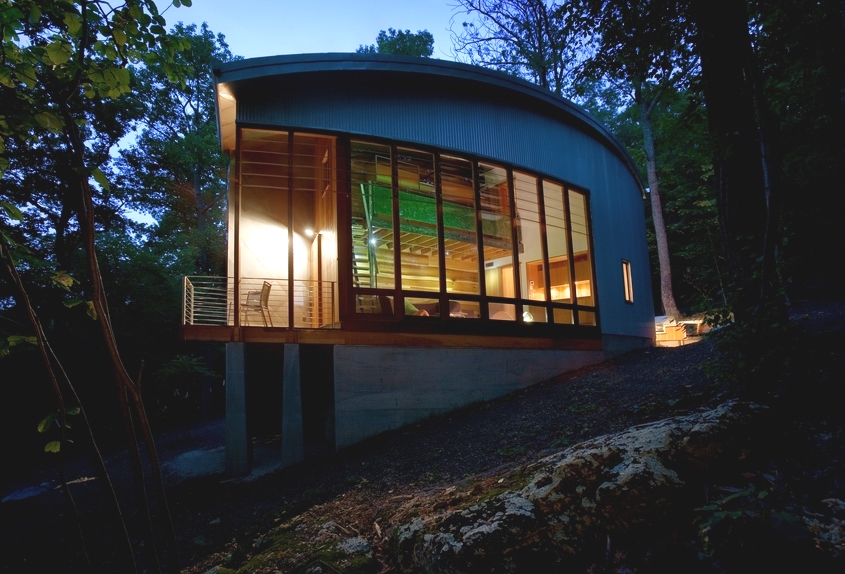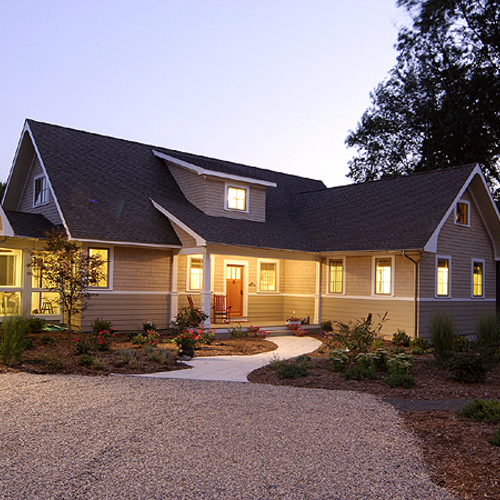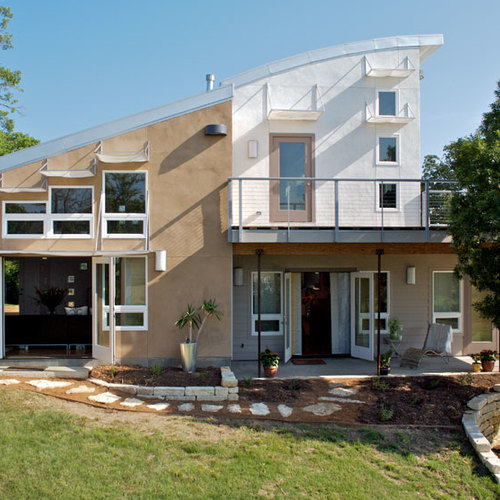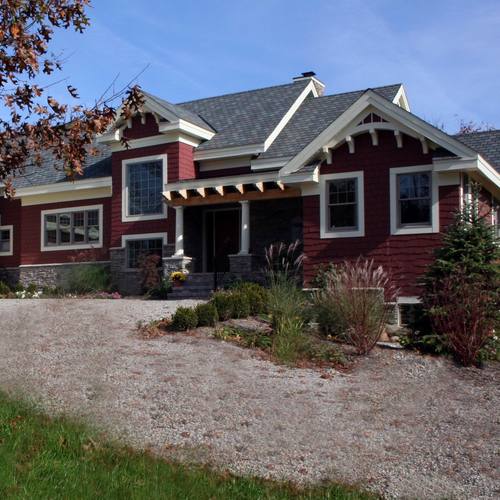
Image Credit: Jim Burton
Image Credit: Jim Burton VIRTUALLY OUTDOORS. On top of adding warmth and light, the custom floor-to-ceiling windows make the small studio feel downright spacious. They were built by a local craftsman from local lumber. In fact, all of the materials — including the poplar flooring and paneling boards that initially formed the curved foundation walls — were sourced from within a 30-mile radius. Hidden bed hatches in the floor are barely noticeable when closed.
Image Credit: Jim A UNIQUE PATH TO THE SECOND FLOOR. The open, staggered-step ladder is in keeping with the extremely efficient use of space in this small studio. It is also visually unobtrusive. Reminiscent of old ship's ladders, it blends well with the nautical feel of the space.
Image Credit: Charles Snead READY-MADE LIVING ROOF. A two-ply waterproofing membrane already lies in place under a root barrier membrane; these are topped off with a water-retentive layer of hydrogel. Building Logics installed these seedling flats of sedum and blueberry, which interlock in place andwill retain 80% of the annual rainfall whem mature. This system ensures that the plants are well secured even before their roots have taken hold.
Image Credit: Jim Burton RESPECT FOR THE SETTING. Nearly every surface of the studio is curved. This adds strength to the structure and softens its visual impact on the natural surroundings. Careful site work meant that the project's area of disturbance barely extended past the foundation's edge.
Image Credit: Charles Snead EXTENDING LIVING TO THE OUTDOORS. To cut down on summer cooling loads, an outdoor cooking area was built into the uphill side of the studio. As with the rest of the project, this terrace disturbed as little of the natural site as possible. The poured concrete walls are made with TXactive cement, a greenhouse gas absorbing material.
Image Credit: Jim Burton AN INTERESTING MIX OF MATERIALS. Hand made and high tech details work side by side in this inventive space. The corrugated metal siding, often found on barns in this region, is employed in a more sleek and contemporary way here. SIPs made sense, not just for their good sealing and insulating qualities, but also to efficiently form the gently curved walls and roof. Soy based foam insulation, locally harvested, reclaimed wood, and air cleaning TXactive cement are just a few of the materials that were chosen for their environmental merits.
Image Credit: Toshi Woudenberg
#Creatively used materials, details, and spaces make this yoga studio and guest house more than equal to the sum of its parts
This thin slip of a building, which sleeps nine people and hosts yoga classes, is actually an ancillary activity space for a main house fewer than 100 feet away.
The foundation, which is made of photocatalytic concrete that cleans itself and the air, sails out from a berm on a steep, forested Virginia slope. The living roof sprouts sedum; a ground-source heat pump (GSHP) provides both heat and hot water; and inside, bed “pods” emerge from the hardwood floors on demand. Though only 600 net square feet, it was an ambitious and fun project to build.
Knowing your goals
Annie and Paul consider themselves “serial renovators,” so at first they weren’t interested in new construction. “No character,” they assumed. Furthermore, they were city dwellers who weren’t comfortable slashing up virgin ground for a second home. They wanted a weekend retreat for themselves, family, and community.
Serendipity led them to an elegantly modern house in the Shenandoah Valley designed by architect Jim Burton. It was a bit small for their needs, but it turned out that Jim had also drawn up plans for a future addition that, with a little tweaking, could accommodate plenty of guests and activities. They bought the house and the intentions.
A connection to nature, a quest for minimal impact, and an affinity for regional materials governed their choices. Local fabrication — an important part of sustainability — led them to engage an area builder and cabinetmaker, Charles Snead, as their general contractor and primary craftsman. They also made sure that all subs and most materials came from within a 30-mile radius.
Because they wanted a participatory experience, not a hand-off to experts, Paul and Charles immersed themselves in evolving Jim’s vision for this building. Paul showed up to work on-site most weekends through construction, as did Jim, whom Paul and Annie retained as architect. Truing the house to an LEED template came later, but it fit right in to the standard they were already using. It went on to become the first LEED Gold house in the southeast United States.
Structural innovation
To answer the need for a clear span of open space and county restrictions on building size, the team employed a structural principle famously used by Thomas Jefferson: the curved wall. The curve provided greater structural strength with less material than a straight wall, thus saving resources. It also created a building shape that responded to passive solar tracking.
Jim, inspired by curved structural insulated panels (SIPs) he had once seen used for boats and airplanes, had no problem selling his adventurous clients on using them in both the walls and the roof. Besides, the SIPs provided high R-value and low air infiltration and contained recycled materials in the oriented strand board (OSB) and expanded polystyrene (EPS) bead foam.
Using Jim’s drawings, which worked off two primary axes, Charles provided CAD shop drawings for the careful integration of compound joinery of walls, windows, and roof. Inside, they built a steel ship’s ladder (another idea with Jeffersonian roots) between the main floor and the loft to save space in the bath, entry, and closet. They installed a stainless-steel ceiling scaled like a fish, which softly reflects diffused light and allowed a smooth finishing of the curved surface without crimps or bulges.
Comfort from a multifaceted system
The GSHP, shared with the main house, employs both a liquid-to-liquid and a liquid-to-air heat pump. Both are moderated by a storage and transfer system that eliminates usual temperature spikes and recovers unused heat.
The liquid-to-liquid heat pump, which runs through a mixing panel, powers the radiant heat under concrete floor areas and provides constant-temperature hot water. The liquid-to-air pump provides forced-air space heating and cooling, and tops off the storage tank with recovered excess building heat.
A heat recovery ventilator (HRV) further recovers heat and incorporates both a humidifier and dehumidifier. A crawl space beneath most of the building acts as a thermal mass to moderate transmitted ground temperature.
Custom components
A curved building necessitated custom fabrication of many parts. Here, the builder’s skills shined and achieved the owners’ goal that the house itself be a piece of art, without anything added. Charles crafted joinery, finish work, windows, and cabinetry, and guided the patterning of the richly grained poplar floor and walls.
He made the steel handrails and much of the hardware, as well as the exterior stainless-steel louvers that provide both privacy and shade.
Charles also hand-ground the concrete floors to a terrazzo-like finish, and burnished the concrete counters derived from overpours (the excess of a delivery that can’t be returned to the concrete plant, usually spilled somewhere on-site). Charles fabricated steel frames for the beds in the loft and helped design the trap-door sleeping berths that sit in the deep floor diaphragm of the main level.
The vegetative roof, a feature now used widely enough to be somewhat prefabricated, was designed to adapt to circumstances. In this case, the curved pitch of the roof would have let direct seeding wash away, so flats of plants were interlocked, each with root systems that were sufficiently grown together to stay that way.
Weekly Newsletter
Get building science and energy efficiency advice, plus special offers, in your inbox.
Lessons Learned
When the owners talk about this studio, they are close to jubilant. They feel that most bad experiences with building are because builders and architects aren’t aligned with owners’ goals. In their case, the exact opposite was true — all were collegial, almost competitive in their similar passion for the goals of this building and commitment to quality. “A pretty high-class problem to have,” said Paul. It’s likely that the owners’ previous experience with building renovations helped, as did their knowledge of and appreciation for good and thoughtful good design.
Ongoing discussions, weekly site meetings, and consultations with other designers and disciplines characterized the evolution of the project. Often, owner and architect would arrive to find mock-ups substantiating various ideas or rehearsing a detail. Charles was encouraged to make innovative suggestions, such as carbon fiber benches for some of the furniture, and then carry them out. Jim’s proposal to finish the straight walls with canvas finished in a resin/beeswax mix brought in artisan Richard Lew, who implemented this.
Jim’s conclusion about using out-of-the-box materials and exploratory methods: “If you’re building a regular sort of house, on a fixed budget, you need to have a tight design . . . it’s very unfair to ask someone to sign on for unspecified tasks for a specified budget, even though lots of contractors work very well this way. Here, we had opportunity and we had talent . . . the stars aligned.”
General Specs and Team
| Location: | Clarke County, VA |
|---|---|
| Bathrooms: | 1 |
| Living Space: | 600 |
| Additional Notes: | Building type: Yoga studio/guest house |
Architect: Jim Burton, AIA, Carter + Burton Architecture, PLC
LEED coordinator: Leesa Mayfield, LEED AP, AIA, Carter + Burton Architecture, PLC
Interior design: Michelle Timberlake, CID, AID, Carter + Burton Architecture, PLC
Builder: Charles Snead, Charles Snead Company, and Paul Mahon
Structural engineer: Tim Painter, Painter-Lewis, PLC
Mechanical engineer: Bill Corish, Corish Engineering
LEED provider: Laura Kapps, Southface
Construction
Foundation: building foundation, slab-on-grade 30% fly ash poured concrete; 7-ft. crawl space; 18-in. LVL joists in main floor (for housing bed "pods") between layers of soy-based urethane spray foam (R-19); elevated section at downhill end on concrete piers on 36-in. x 36-in. footings; grill/terrace is 8-in. poured concrete with TX Active photocatalytic cement on gravel base inset with slate pavers
Walls: 6-1/2-in.-thick SIPs (R-24).
Windows: operable low-e, double-pane glass, wood frame (U-factor .34 and SHGC 0.69)
Roof: prefabricated 8-1/2-in. SIPs, (R-31); living roof made of modular planting trays with filter fabric and retention layer with thermally bonded polyester and copper inlay, 4-ply polymeric bitumen sheet (Building Logics)
Energy
- Natural daylighting, reflective and LED lighting
- Passive solar siting and design
- High-performance building envelope
- Remote equipment monitoring
- Energy Star refrigerator drawers;, high-efficiency all-in-one washer-dryer
- In-floor hydronic heating in bath, laundry, and entry
Energy Specs
Heating/cooling/water heating: Geo-exchange system with HRV; heat exchanger connected to both liquid-to-liquid and liquid-to-air heat pumps. Thermal storage system uses aqueous heat transfer media. Desuperheater with thermal storage tanks provides hot water.
Cost: about $70,000.
HERS index: 65
Water Efficiency
- No irrigation system; local, drought-tolerant plants
- Living roof retains up to 70% of rainwater (Building Logics).
Indoor Air Quality
- HRV
- No paint
- No-VOC adhesives or finishes
- No carpets
Green Materials and Resource Efficiency
- Built to a 100+-year standard
- Some construction waste recycled; SIP scraps used in scaffolding
- Poplar boards used to form concrete foundation walls repurposed as interior wall paneling and flooring
- Space planning for compact size and multiple uses
- Curved SIPs for walls and roof eliminate interior columns and provide zero air infiltration, high insulation values, and maximum strength
- FSC-certified lumber for other framing
- Maintenance–free galvanized metal siding
- Terrazzo-ground countertop made from concrete overpours
- Beeswax and resin on canvas over no-VOC MDF sheathing on all straight walls
- Custom fir doors, windows, and cabinets built locally
- Vegetable oil used as concrete form release agent
Certification
LEED for Homes: Gold










0 Comments
Log in or create an account to post a comment.
Sign up Log in